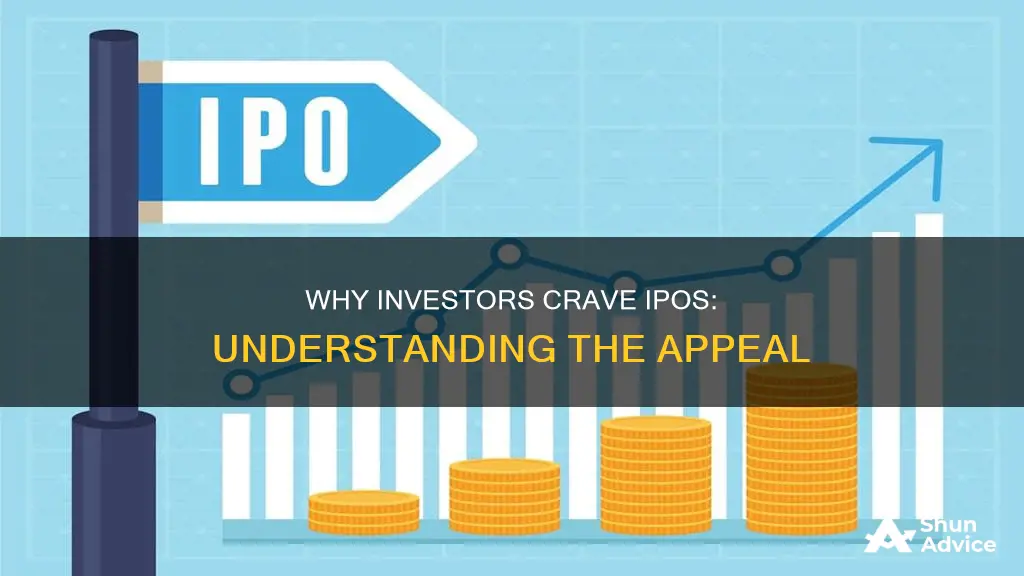
Investing in an IPO, or Initial Public Offering, can be an enticing prospect for investors. An IPO is when a company makes its stock available on a public exchange for the first time, and it can be a significant milestone for a company's growth. However, it's important for investors to approach IPOs with caution as they can be risky. When considering investing in an IPO, it's crucial to look beyond the hype and conduct thorough research. This includes analysing the company's overall vision, competitive landscape, and financial history. While IPOs offer the opportunity to invest in stocks with potential for quick growth, they also carry a high level of risk due to the lack of market history and volatility in initial pricing.
What You'll Learn

The potential for high returns
For example, one of the most successful IPOs was Alibaba's $22 billion raise when it joined the New York Stock Exchange in 2014. Google's IPO in 2004 is another notable success, with the stock rising over 177% in the year following its debut.
However, it is important to note that IPOs are considered high-risk investments, and not all IPOs result in long-term success. Investors should exercise caution and conduct thorough research before investing in an IPO to ensure they understand the potential risks and rewards.
Making Investments: Dave Ramsey's 10 Percent Rule Explained
You may want to see also

High risk and volatility
Initial public offerings (IPOs) are considered high-risk investments. Newly public companies are often deemed high risk and volatile because they lack a proven record of operating in the public domain. IPOs can be more speculative than established stocks, and it can be difficult to assess their financial history and prospects.
The first day of trading for an IPO is typically very volatile. Without any trading history or prior stock quotes, it is challenging to determine a fair market-based price for the stock. Investors are generally advised to wait several weeks or longer to allow the IPO to stabilise in price. This initial period can present more attractive buy-in opportunities as the price corrects after the initial hype.
The lack of market history also makes it difficult to perform technical analysis and ascertain the fair market value of the company issuing the IPO. This can lead to initial price volatility, and even popular companies can fall in price once the stock goes public.
Companies issuing IPOs may also have lower liquidity than more established companies, implying a lesser ability to pay debt obligations or liabilities. This further increases the potential risk attached to companies that have recently launched an IPO.
The potential for high returns from investing in IPOs is counterbalanced by significant risks. Accurately assessing and valuing a company can be difficult, and the initial price may be too high, leading to a depreciation in value. IPOs are generally more suitable for investors with a longer time horizon who can bear the risk of substantial losses.
Invest in Me: How to Make Him Want More
You may want to see also

Lack of historical data
When a company launches an IPO, it can be challenging to ascertain its fair market value due to limited market history. This can lead to initial price volatility, and even popular companies can experience a drop in price once their stock goes public.
A company filing to go public may be an unknown entity. While they must supply investors with financial information before listing, there is often no lengthy historical financial data to review, making it difficult to determine an IPO's prospects.
The opening price of an IPO is crucial, as it is the price at which the stock begins its exchange-listed life on its first day of trading. Accurately pricing an IPO is challenging, even for experienced investment banks. The company holding the IPO wants a high price, while investors prefer a lower price, and it is up to the banks to find a middle ground.
The lack of historical data can make it difficult to assess the financial history and prospects of an IPO-issuing company, resulting in a more speculative investment than established stocks. This can be a risky proposition for investors, as it is challenging to determine whether the IPO is overvalued or undervalued.
Investors should exercise caution and conduct thorough research before investing in an IPO, especially considering the potential for initial price volatility due to the lack of historical data.
FDI in India: Exploring the Attractive Investment Opportunities
You may want to see also

Company growth potential
When considering investing in a new IPO, it is important to assess the company's growth potential. This involves evaluating the company's business operations, financial health, competitive landscape, and future prospects. Here are some key factors to consider:
Business Model and Operations
Investors should understand the company's business model, products or services, target market, and competitive advantages. Assess whether the company has a unique selling proposition and a sustainable business model that can drive long-term growth. Look for companies with dynamic products that are transforming their industry.
Financial Performance and Prospects
Review the company's financial statements, including income statements, balance sheets, and cash flow statements. Analyze their revenue growth, profitability, and financial health. Look for companies with consistent and robust financial performance, as well as strong growth prospects in their industry.
Management and Leadership
The quality of a company's management team and leadership plays a crucial role in its success. Evaluate the experience and track record of the company's executive leaders. Assess their ability to make strategic decisions, adapt to market changes, and drive innovation.
Market Position and Competition
Analyze the company's market position and competitive landscape. Look at their market share, barriers to entry, and competition within their industry. Assess whether the company has a strong value proposition that sets them apart from their competitors. Consider the potential impact of new entrants or alternative solutions on their market position.
Growth Strategy and Opportunities
Understand the company's growth strategy and expansion plans. Evaluate their ability to capitalize on new market opportunities, expand into new geographies, or diversify their product offerings. Look for companies with a clear vision for growth and the resources to execute their strategy effectively.
Industry Trends and Market Dynamics
Stay informed about industry trends and market dynamics that can impact the company's growth potential. Assess the overall health and outlook of the industry, including technological advancements, regulatory changes, and consumer behavior shifts. Identify potential risks and opportunities arising from market trends and their impact on the company's growth trajectory.
When assessing the growth potential of a company offering a new IPO, investors should conduct thorough research and due diligence. This includes analyzing financial reports, industry data, and company disclosures. It is important to remember that investing in IPOs carries a higher level of risk due to the limited track record and market history of the company. Therefore, investors should carefully consider all factors before making an investment decision.
Diversifying Investments in India: Strategies for Success
You may want to see also

Long-term outlook
When considering investing in an IPO, investors should be cautious and avoid getting caught up in the excitement and hype that often surrounds a company going public. IPOs can be a risky investment due to the lack of historical financial data and market history, making it challenging to accurately assess the company's value and future prospects. Therefore, investors should focus on the long-term outlook and potential rather than short-term gains driven by initial hype.
One key consideration for investors is the company's growth potential and ability to generate consistent growth over the long term. While IPOs offer the opportunity to invest in companies with high growth potential, it is important to remember that not all IPOs will be successful in the long run. Investors should carefully analyse the company's overall vision, competitive landscape, and financial health before making a decision.
The long-term outlook for an IPO also depends on the company's ability to raise capital and fund its future growth plans. IPOs are typically launched by companies seeking to raise a large amount of capital to expand their operations. Investors should assess the company's financial needs, the intended use of the funds raised, and the potential return on investment.
Another factor influencing the long-term outlook is the company's stability and ability to navigate the challenges of being a public company. Newly public companies often face increased scrutiny, regulatory requirements, and pressure to perform. Investors should consider the company's management team, business practices, and ability to adapt to the changing market conditions.
Additionally, investors should evaluate the IPO's valuation and whether it is fairly priced. Accurately pricing an IPO is challenging, and the initial price may be subject to correction after the stock starts trading. Investors should be patient and monitor the price stabilisation process to identify more attractive buy-in opportunities.
In summary, when considering the long-term outlook of investing in a new IPO, investors should focus on the company's growth potential, financial health, ability to raise capital, stability, and valuation. By carefully evaluating these factors and maintaining a cautious and patient approach, investors can make more informed decisions and potentially benefit from the long-term success of the company.
Investing in Tesla: A Guide for Indians
You may want to see also
Frequently asked questions
IPO stands for Initial Public Offering. It's when a company makes their stocks available to investors on a public exchange for the first time.
An IPO offers investors something new in the market. It can be a chance to invest in a small company with high growth potential, or in an existing company with a proven track record. The price per security issued is usually fairly affordable for all investors.
IPOs are considered high-risk investments. With limited market history, it can be hard to ascertain the fair market value of the company issuing an IPO, which can lead to initial price volatility. Companies that issue an IPO may also have less liquidity than more established companies, implying a lesser ability to pay debt obligations or liabilities.
IPOs offer investors the opportunity to invest in stocks that have the potential to rise quickly in value. It can also be a chance to get in on the ground floor of a stock with high upside potential.







